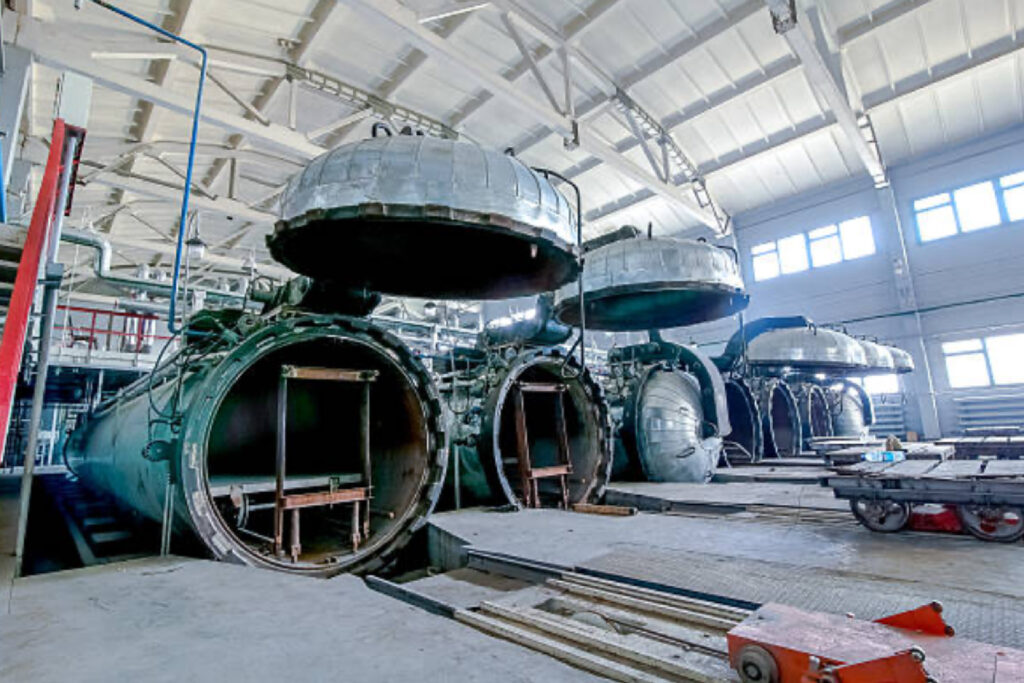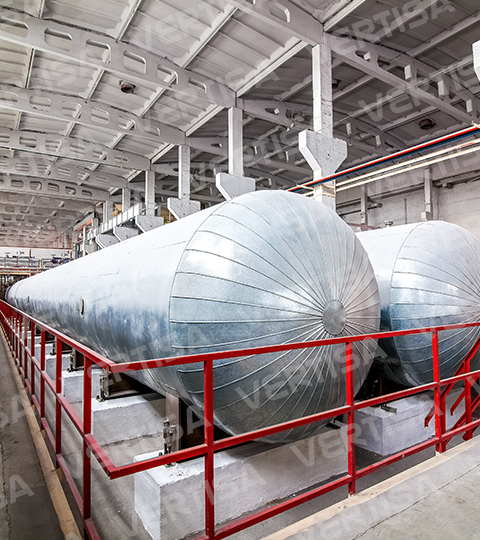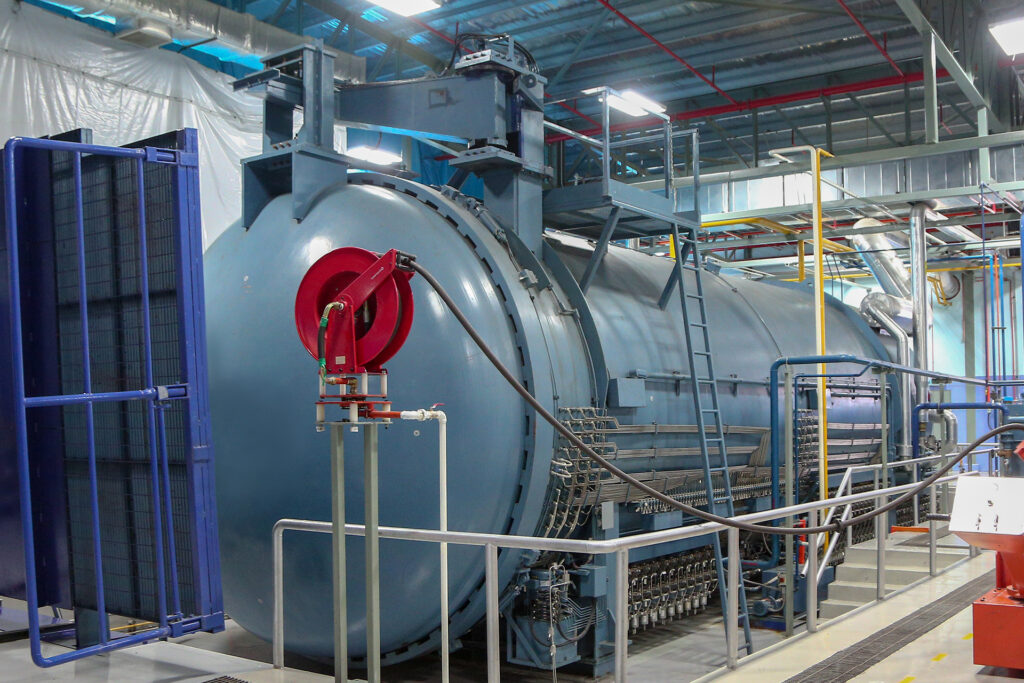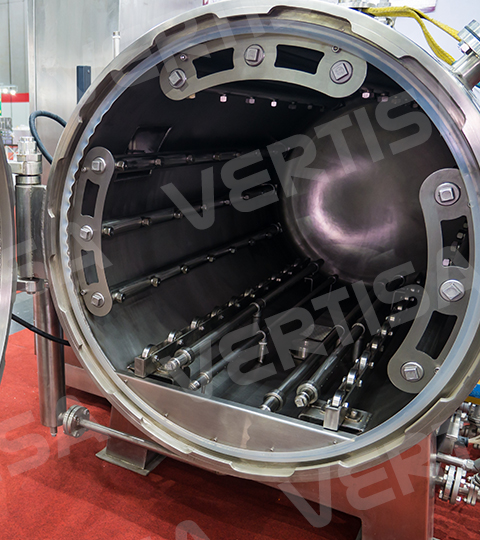Vertisa Glass Lamination Autoclave Systems

Glass Lamination Autoclave
Laminated glass is essentially safety glass made by joining two or more glasses of variable thickness, placing one or more layers of polyvinyl butyral (PVB) between them, and then placing the assembly in an autoclave.
On a standard cycle, the glass should reach 140ºC (280ºF) and 12.5 bar (180 psi) of pressure after being placed in the autoclave and remain under these conditions for at least 60 minutes. However, these conditions may vary depending on the thickness and number of panels.
01.
User Friendly
02.
Completion On Time
03.
Custom Designs Available
04.
Precision Temperature Control
05.
Even Heat Distribution
06.
Durable Autoclaves
07.
Full/Semi-Automatic Controls
08.
Cost-Effective Units
We Provide The Best Service In Industry
Autoclave And Glass Lamination
In recent years, the use of glass in the most technologically advanced projects has become widespread and the production process has shifted from practical craft methods to unprecedented industrialization.
Use as a structural element, Laminated glass has become a central and essential element in the construction of any building. An increasing number of natural disasters (tsunamis, earthquakes, etc.) in recent years have made it necessary to design safer buildings and develop stricter laminated glass production standards worldwide.
This demand has increased the international presence of autoclaves produced by VERTISA, one of the leading suppliers in the sector.
Regarding energy efficiency with smart laminated glasses, it can absorb sunlight or dim automatically according to outside light conditions.

Laminated Glass Cycle In Autoclave
To optimize the productivity of the autoclave, it is essential to work with the supplier to accurately define the maximum time to reach these temperature and pressure conditions.
The data provided below is a good tool for comparing and ranking different autoclave offers. Heating ramp rate: As a starting point and standard value in the glass industry, we recommend a heat ramp rate of 2ºC/min, which will allow us to go from 20ºC to 140ºC in 60 minutes.
Vertical Airflow Autoclave Heating Test
VERTISA offers an innovative design for autoclaves with very long or continuous production lines for the lamination of windshields. These include vertical airflow and top-mounted motors to ensure optimum and uniform air distribution within the autoclave.
VERTISA has focused its efforts on creating a “smart” autoclave by focusing on improvements in energy efficiency, availability, predictive control, and low maintenance.
VERTISA automation control software includes all these features that reduce the consumption costs of the autoclave, increase its productivity and optimize the periodic maintenance tasks that need to be done.
Our technical service can provide front-end support to every country in the world, thanks to its high level of connectivity and incorporation of the most advanced solutions in remote connection.
10 to 40 Meters
12,5 Bar
134 to 140 C°
Air CO2 GN2
Electric Heat Transfer Fluid
- Rupture Disc
- Safety Relief Valve
- Shielded Electrical
- Heating Unit
- Blower Motor
- Circulating Fan
- Cooling Coil Heat
- Exchanger
- Quick Opening Door
We Provide The Best Service In Industry
Standard Features
- Encapsulated blower motor eliminates the high maintenance necessary for the vessel shaft sealing.
- Proprietary blower motor design allows operation at any combination of pressure and temperature.
- Engineered circulating fan assures excellent heat transfer to the load and exceptional temperature uniformity.
- A cooling coil is a single-pass heat exchanger designed for precise temperature control with ample provisions for thermal expansion to minimize thermally induced stresses and failure.
- “Man-Inside” emergency alarm cables are provided on larger autoclaves, allowing operators to completely disable all autoclave sub-systems. It requires an autoclave door to be opened to reset the alarm.
- The loading track and floor are designed to allow for thermal expansion yet provide full structural support.
- Safety relief valves and rupture discs are provided on separate vessel penetrations to assure independent and safe operation. Many other redundant safeties are incorporated to assure operattor and equipment protection.
- Most vessel penetrations, such as vacuum, thermocouple, and cooling, are removable. This allows easy modification or repairs without compromising the vessel’s structural integrity.

Opening Door Features
- This proprietary breech lock door allows full and easy access to the autoclave interior within one minute after the completion of a curing cycle.
- Safety is inherent in its design, but we also include mechanical, hydraulic, electrical, and pneumatic interlocks to prevent door operation while the autoclave is pressurized.
- An oxygen sensor/fresh air purge safety interlock is available to prevent opening the door unless safe levels of oxygen are present.
Instrumentation Options
- Optimized Cycle Processing for maximum production and Highest Quality
- Guaranteed Soak
- Glass Temperature Monitoring
- Automated Vacuum Leak Checking
- Natural Pressure Decay of Temperatures and Pressure
- Interactive Screens
- Multilevel Security
- Multiple Equipment Computer Control Monitoring Recording with Backup
- Programmable Microprocessor-Based Controls System
- Set Point Controls
- Honeywell Computer Controls
- Manual Controls
- Network Compatible Computer-Based Control Systems
- Data Logger Recorder
- Strip Chart
- Circular Chart
- Computer
- Automatic
- Manual
- Gauges
- Transducers
Vacuum System And Cooling Systems
VERTISA is currently collaborating with the world leader in autoclave manufacturing for glass lamination. This leadership is mainly based on combining traditional and innovative engineering with deep knowledge of both the autoclave and the process.
VERTISA is thus able to offer its customers a turnkey solution option for glass lamination that includes all auxiliary systems that complement the autoclave:
Automatic vacuum system consisting of a lubricated rotary vane vacuum pump and a series of inlets selected by the customer based on the number of panels to be laminated in the vacuum bag Manual, semi-automatic, and automatic loading systems. Cooling systems with our compact solution include a cooling tower, air refrigerator, chiller, heat exchanger, or a combination of these state-of-the-art compressors from the best brand.
Silencer for low sound emissions during depressurization hardware and sensors to monitor processes.
The option to choose a single supplier for both the autoclave and its ancillary equipment facilitates communication and integration between them and provides a higher probability of success in the outcome of the project.

Opening Door Features
- External Cooling System
- Bridge Mechanism
- Oxygen Sensor/Air Purge/Safety
- Interlocks
- Vacuum Pumps
- Lift Tables
- Bridges
- Load Carts
- Related Safety Equipment
- Valves
- Piping
- Pumps
- Door Safety Interlocks
- Over-Pressure and Over- Temperature Protection Options
- ‘Operator-Inside’ Alarms
- Blower Motor Cooling Alarms
- Steam Separators
- Storage Tanks
- Cooling Towers
- Pumps
Opening Door Features
- Inspection
- Installation
- Non-Destructive Field
- Testing
- Training for New
- Systems
- Analysis of Equipment
- Design and Engineering
- Evaluation
- Fabrication
- Complete Turnkey Installation
- Freight On Board (FOB) Factory
- Services
- On Site Start-Up/Operation/Maintenance Training
Major Sectors Using Autoclaves For Glass Lamination
Backed by thousands of international references and top customers, the company’s experience has grown over the years based on values such as excellence, hard work, and constant innovation. It is
evident in the many processes that use and integrate VERTISA autoclaves and control systems.
The result is a wide range of products: from the simplicity of small glass panels for the home to windshields in cars and buses to smart interactive glasses that will soon become a part of our daily lives.
There are endless possibilities that make it possible to produce complex laminated glass in sizes and shapes that were unimaginable just 10 years ago.
VERTISA is actively involved in ongoing and NEW projects that will change our future, adding hard work, excellence, and innovation to unprecedented technological solutions for the production of autoclaves for glass lamination.
As a result, increased consumption and production of laminated glass is now a fact of life, with sales volumes exceeding 40 billion soon.
Today, VERTISA is a reliable partner that can meet this challenge anywhere in the world.
General Features Of Autoclave
| Working Temperature Up To 140 Degrees C° | Control Systems |
| Working Pressure Up To 20 Bar | Duel Loop Profile Controllers |
| 0.5m To 5m Working Diameter | Heating Medium: Electric Or Gas |
| 1m To 30m Working Length | Number Of Vacuum Connections |
| Electric Or Gas Powered | Number Of Product Thermocouples |
| Comply With International Pressure Directives | Manual Or Fully Automatic Door Systems |
| Fully CE Marked | Nitrogen Pressurization |
| Variable Vacuum | Fully Integrated Cooling |
| Component Loading Systems | Trolley Loading Systems And Stacking Racks |
| Compressor System | Comprehensive User Manual |
| Full Turn-key Installations | Comprehensive Training Packages |